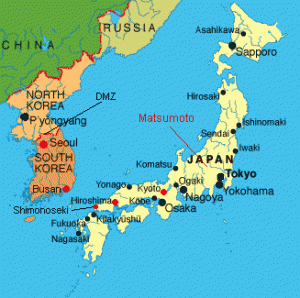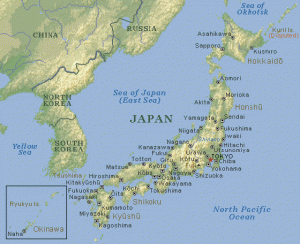Japan is a fascinating country of economic and business prowess, rich culture, technical wizardry, spatial conundrums and contradictions. Japan held onto the title of the world’s second largest economy for more than 40 years from 1968 to 2010. Tokyo, Japan’s capital city, is the world’s largest metropolitan area, with a population of 32.5 million people. Despite having an area slightly bigger than Germany and smaller than California, Japan is the world’s tenth largest country by population, with 127.3 million people.
Japan Map
(Click on the image below to view the full-size map in a separate browser tab or window.)
Japan Facts, Statistics and Information
Population: 127 million people (2010, 10th largest country in the world by population)
Total area: 145,920 sq. miles (377,930 sq. km, 61st largest country by total land area, one ahead of Germany (137,882 sq. miles) and slightly smaller than California (163,696 sq. miles))
Capital city: Tokyo (population: 13 million (city), 32.5 million people (metro area); The Tokyo metropolitan area is roughly 50 percent larger than Seoul, South Korea, the world’s second largest metropolitan area with a population of 20.5 million people.)
Largest Japanese cities (by population, from most to fewest people): Tokyo, Yokohama, Osaka, Nagoya, Sapporo, Kobe, Kyoto, Fukuoka, Kawasaki, Saitama, Hiroshima, Sendai, Kitakyushu, Chiba
Ethnic groups: Japanese (approx. 98.5% of population), Koreans (0.5%), Chinese (0.4%), Other (0.6%)
Language: Japanese (prominent dialects include Kansai, Osaka, Kyoto, Tohoku, other)
Climate and weather: Japan’s climate ranges from humid continental on the northern island of Hokkaido to humid subtropical on parts of Honshu south to Okinawa Prefecture on the Ryukyu islands.
UNDP Human Development Index (HDI): 0.884 (2010, 11th in the world)
GDP per capita (International $, PPP): $32,554 (2009)
Life expectancy at birth: 83.2 years (world’s longest life expectancy)
Geography of Japan
Japan is an archipelago of some 6,852 islands located in a volcanic zone on the Pacific Ring of Fire. A nearly continuous series of ocean trenches, volcanic arcs and shifting tectonic plates, the Pacific Ring of Fire accounts for more than 75 percent of the world’s active volcanoes and 90 percent of the world’s earthquakes.
Japan’s four main islands, Honshu, Hokkaido, Kyushu and Shikoku, make up 97 percent of the country’s total land area. Honshu is home to Tokyo and many of Japan’s other largest cities, including Yokahama, Osaka, Nagoya, Kobe, Kyoto, Kawasaki, Saitama, Hiroshima and Sendai.
Hokkaido, the second largest Japanese island and northernmost prefecture, accounts for nearly a quarter of Japan’s arable land. Hokkaido leads Japan’s other 46 prefectures in the production of seafood and a host of agricultural products, including soybeans (the key ingredient for tofu and all things miso), wheat, corn, beef and raw milk. Sapporo, Hokkaido’s capital and largest city, hosts the annual Sapporo Snow Festival, which regularly draws more than 2 million visitors to the spectacular exhibition of some 400 snow and ice sculptures.
Kyushu, the third largest and most southern of Japan’s four main islands, is the site of Japan’s most active volcano, Mt. Aso, and several cities with important historical, political and commercial significance, including Nagasaki, Kagoshima and Fukuoka.
Tohoku Earthquake and Tsunami
Few are likely to ever forget the shocking images of the massive wall of Pacific Ocean water that engulfed embankments and effortlessly swept away everything in its path in Japan’s Tohoku region in March, 2011. The most powerful earthquake to ever hit Japan, and the world’s fifth most powerful quake in modern history, unleashed waves that reached heights up to 40.5 meters or 133 feet in the city of Miyako. The devastation wrought by Japan’s Tohoku earthquake and tsunami accounted for 57 percent of total economic damages from natural catastrophes and man-made disasters in 2011.
Japan’s Economy, Business and Development
Japan is the world’s third largest economy, having ceded the second spot to China in 2010. Since the collapse of the property bubble in 1989, Japan has faced extended periods of economic stagnation, deflation and relatively high unemployment, at least compared to the nearly full employment Japanese companies managed to sustain for much of the post-WWII era. Among other issues, Japan’s economic performance has been constrained by weak domestic demand and a rigid labor market that has limited risk taking and entrepreneurial activity.
Despite Japan’s challenging domestic economic environment, many Japanese companies have continued to perform well on the world stage. As of 2011, Japan counted 68 companies in the Fortune/CNN Money Global 500 ranking of the world’s largest corporations. Japanese companies in the top 100 of the Fortune ranking include: Toyota Motor, Hitachi, Honda Motor, Nissan Motor, Panasonic, Sony and Toshiba. Japan’s corporate sector has continued to push the technology envelope in fields such as robotics, medical devices, clean energy, satellite communications and spacecraft, water processing and other high tech industries.
Toyota became the world’s largest car company in 2009, before losing a bit of ground to unprecedented product recalls. Nintendo’s innovative Wii marked a virtual revolution in the large, global market for gaming and family entertainment products.
Japanese Society, Language and Culture
Japanese society is strikingly homogenous. Ethnic Japanese account for 98.5 percent of the country’s sizeable population. While different areas of Japan, particularly the central Kansai region encompassing Osaka, Kyoto and Kobe, are known for having distinctive, colorful local dialects, the whole country essentially speaks the same language.
Traditional Japanese society and culture stress the values of harmony, consensus decision-making and social conformity. “The nail that sticks out gets hammered down” is a common Japanese saying and guideline of social behavior.
Japan’s Aging, Shrinking Population
Japan’s population has been aging and shrinking at an alarming rate due to the combination of a disproportionately large elderly population, one of the lowest fertility rates of any developed, OECD country and minimal net immigration. Japan’s fertility rate of roughly 1.2 children born for every Japanese woman is well below the replacement level of 2.1 children per woman that is needed to maintain the existing population level. By 2050, the population of Japan has been forecasted to contract by more than 25 percent to about 95 million people.
International Relations and Foreign Policy
Japan has deliberately elected to take a largely passive stance toward involvement in international conflicts and disputes for most of its post-WWII history. Article 9 of The Constitution of Japan, adopted on November 3, 1946, renounces going to war or “the use of force as a means of settling international disputes.” In lieu of a conventional military, Japan established the Japan Self-Defense Forces (also known as the SDF, JSDF or Jietai) as an extension of the Japanese police force and a strictly defensive mechanism to provide for the country’s national security and assist with national emergencies.
Japan first deployed the SDF abroad in 1991 when it dispatched minesweepers to the Persian Gulf after fighting ceased in the 1991 Gulf War. Since Japan enacted the International Peace Cooperation Law in 1992, the Japanese government has deployed the SDF on certain overseas missions to support the U.N.’s international peacekeeping operations.
Japan largely relies on the U.S. for protection against external threats. Under the 1960 Treaty of Mutual Cooperation and Security between Japan and the U.S., the U.S. has agreed to defend Japan if the country or any of its territories come under attack. Roughly 40,000 U.S. military personnel and civilians in defense roles are stationed or employed on U.S. military bases located across Japan.
The majority of U.S. military personnel in Japan are stationed on the main island of Okinawa Prefecture in Japan’s Ryukyu Islands, where U.S. military bases occupy about 18 percent of the territory. Japan pays roughly $2 billion as annual host-nation support to cover the costs and defense services of the U.S. military presence in Japan.
Related Articles and Content about Japan
Global Sherpa country profiles and topic pages: China, South Korea, India, Brazil, BRIC Countries, Development, Sustainability, Globalization, World Rankings
Aging 150 Year Old Japanese in Abundance – Health Secrets and Population Issues
No Earthquake Looting? Trust Japanese “Wa”


